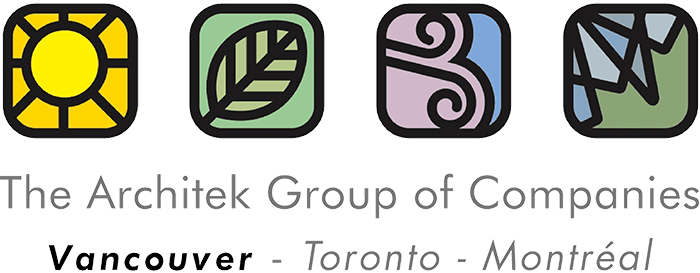Green roofs are much more than just beautiful rooftop gardens. They help decrease air and noise pollution, reduce heat by absorbing sunlight, and manage excessive stormwater runoff. Green roofs can even improve your overall wellness by increasing your energy levels and brightening your mood. With the number of benefits green roofs provide, it’s not surprising that the living architecture industry is thriving. But what really goes into creating a thriving green roof?
“There’s no one size fits all approach to the green roof industry,” says Ron Schwenger, a certified green building professional and principal at Architek, a leading living architecture distributor based in Vancouver, British Columbia. “All horticultural and architectural circumstances must be taken into account.”
With a background in architecture and fine arts, Schwenger founded Architek in 2005, hoping to strengthen the living architecture industry in North America. By partnering with well-established developers like the German company ZinCo, Architek provides design support, installation, and maintenance for living architecture systems, including green roofs. These are just a few of the most overlooked and essential factors that must be considered to build a green roof that not only survives, but thrives.

1. Make sure the plant selection is best suited for the location.
When selecting plants for a green roof, you should reference your location on a Regional Hardiness Zone map. Most regions in North America are divided into unique horticultural Hardiness Zones. These maps rank areas from 1-7, 1 being the harshest growing conditions, 7 being the mildest.
Using plant species that are native to the area gives your green roof the best rate of success. In general, the most popular plant species for green roofs is the succulent sedum, which is well-suited for shallow roof systems. Sedum is also tolerant of harsh conditions such as droughts.

2. Use an engineered, reliable green roof approach.
Green roofs have been around for hundreds of years. During the Viking Age, green-roofed villages were quite common as sod acted as a natural insulator. However, engineered green roofs are a more recent development. The practice of engineering green roofs began about 50 years ago in Germany.
Architek has a strong, collaborative relationship with ZinCo, a green roof manufacturer that was founded in Germany in 1957. ZinCo uses an efficient layered design that separates the three main goals of a green roof: protection, drainage, and growth. “Using an engineered system is the best method to ensure long-term success and a green roof that thrives,” Schwenger says.
The green roof industry in North America is still in its infancy compared to Europe. “We have a tendency in North America to think that we can do things better,” Schwenger says. “But why not benefit from the expertise and the proven track record of the well-established green roof industry in Europe? That’s been my approach from the very beginning.”
Schwenger encourages green roofers to stick with trusted European methods rather than falling for gimmicks and trends. In Europe, the green roof industry is performance-oriented, focusing on durability and sustainability. In contrast, the North American green roof industry is driven by economic and value engineering. At Architek, Schwenger attempts to bridge the gap between the two, bringing European knowledge and skill to the North American marketplace while still being highly cost-effective.

3. Use the proper substrates and/or engineered growth media.
“Using low grade topsoil and inappropriate substrate is the leading factor for green roof failures and subsequent building envelope damage,” Schwenger says. He recommends always using a grow media mix that is best suited for the horticultural environment and building architecture.
If you are dealing with a landlocked, arid environment, you need to mix grow media suited for water retention. On the other hand, green roofs in coastal, rainy environments should have grow media that are less absorbent, allowing for effective water drainage.

4. Ensure the green roof has the right balance of water and drainage.
Green roofs act as sponges. By soaking up water and delaying the flow of water runoff, green roofs give sewer systems enough drainage time, which helps prevent flooding. Green roofs also serve as a natural filter, improving the quality of stormwater runoff.
But depending on the region—from humid rainforests to arid prairies—you must account for distinct water and drainage needs. Water retention mats, soil mixes, and plant and regionally appropriate irrigation plans must be considered ahead of time.
“Proper levels of water retention, drainage measures and irrigation options need to be designed in from the beginning,” Schwenger says. You need to make sure the average amount of rainfall in your region does not outweigh the green roof’s saturated weight, or the maximum amount of water that a green roof can hold.

5. Keep up with weeding and maintenance.
It’s a common misconception that green roofs don’t require any maintenance. “Every green roof is different when it comes to maintenance needs.” Extensive landscaped roofs require the least amount of upkeep because they are lightweight and shallow. “Extensive green roofs with sedums can do quite well with minimal maintenance, however some weeding and maintenance is required even on the simplest of green roofs.”
On the other hand, intensive roofs are essentially rooftop gardens; they need more continual maintenance because they have a deeper build-up. Your regular upkeep routine for an intensive roof depends on which plants you choose (lawns, perennials, shrubs, trees, etc.). For slope green roofs, irrigation systems require seasonal maintenance.
Despite what you may think, maintaining a green roof costs less than a conventional roof. “If green roofs are done extremely well, they’ll protect the building,” Schwenger says. “They last three or four times as long as normal roofs.” In short, green roofs provide a return on investment because of their durability.
By Julia Stone originally published at gbdmagazine.com




